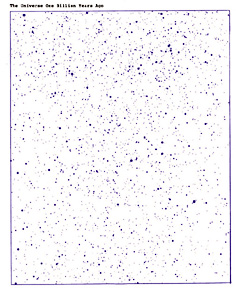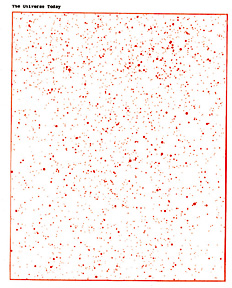No Edge, No Center -- Exploring the Shape of Our Universe
Think about this for a moment: If the Universe is infinite, it has unlimited volume; if the Universe is finite, it has a limited, measurable volume. Remember now, we are not talking about boundaries, for this is another matter. A boundary is an edge of space. If we were to reach a boundary in space, we can go no farther.
In general, the human mind tends to have the following conception: if the size of something is finite, then it must have an edge or boundary of some sort. For it to have no edge or boundary, it must be infinite. So since we can't conceive of coming to the edge of space (after all, what would then be outside it?), space must be infinite.
We will explore this misconception in this exercise. In doing so, we will exercise our abilities in both deductive and inductive reasoning. Deductive reasoning is the process of demonstrating that if certain statements are true, then other statements can be shown to follow from them. Inductive reasoning stems from making conjectures based on observations and the patterns we see emerge from observations. Both forms of reasoning will be used in investigating the shape of our Universe.
We will see that there are shapes which are finite in size, but which have no boundaries. We will have to let go of many of the limitations put on us by our familiarity with the 3-dimensional world in which we live. Be prepared to think differently. Remember that in the following exercises we get to see more than we would see if we were confined to the surfaces we will investigate -- because we have another dimension or two available to us from which to look!
Student Worksheets

Teacher Notes

Lesson One
In this lesson, students will examine various "spaces" (including ones
that are one-dimensional, two-dimensional, and three-dimensional). For each
space, they will examine what it means to have or not have an edge, or to be
finite or infinite.
Answer Key
- Beings in the one-dimensional Universe will be either line segments or
points. Number 2 can only see 1 and 3, never 4 nor 5. Each being can see two
others except for the ones on each end; the end beings see only one other
being in their Universe.
Line segment: finite with boundary; Circumference of Circle: finite with
no boundary; Ray: infinite with boundary; Line: infinite with no boundary
Interior of circle: finite with boundary; Surface of Sphere: finite
with no boundary; Half plane: infinite with boundary; Plane: infinite with
no boundary
Both are finite with no boundaries.
- If you looked up, you'd see the bottoms of your feet. If you
looked to the left, you'd see your image, viewed on your right side. If you
looked forward, you'd see another image of you, viewed from behind.
A 3-torus is finite with no boundary.
Lesson Two
In this lesson, students will explore the concept of whether or not there
is a "center" to the Universe. The lesson begins with an exercise in
deductive reasoning and direct proof. This is followed by hands-on
activities where they will observe for themselves that, when space is
expanding, where the center is depends completely on from where you observe
the expansion!
Answer Key and Instructions
If the Universe began with an explosion, then the Universe must be expanding. If the Universe is expanding, it has no center. Therefore, if the Universe began with an explosion, it has no center.
Proof:

If the Universe began in an explosion and is expanding, is it or is it
not required to have a center? No. Once the Universe began to expand, it
became like an expanding surface. Space itself was expanding. Once objects
began to appear in the Universe, we had some "markers", if you will, against
which to establish coordinate locations. Try as we might, however, we have
never been able to use these galaxies to establish a spatial preference in
the Universe. There is no center, and all of space seems to be expanding
away from all of the rest of space. No matter where you are.
Can we take all of the objects in the Universe, trace their motions
backward in time to arrive at a single intersection point, i.e. at the point
at which the big bang occurred? If so, this point would truly be the center
of the Universe. However, such a point does not exist.
Let's Investigate Activities
Regardless of which galaxy they pick to be the center (and therefore
measure all of the other galaxies relative to), all of the other galaxies
will appear to be moving away from the selected center.
The same thing which occurred for the elastic band will happen for the
balloon or ball.
You can now lead your students through a visualization of the ideas
explored above, namely, every point sees itself as the center from which
everything else is expanding. You will need to print the two images below on
transparencies. If you don't have access to color, black and white will still
work.
The transparency in blue shows what a portion of the Universe may have
looked like about one billion years ago. The red transparency shows what
that section would look like today. Place each sheet on the overhead
projector one at a time. Look at each sheet. Is there an obvious "center" to
the distribution? Now put the red sheet over the blue one, lining up the
outer rims. Have students discuss and describe the pattern which emerges.
Shift the top sheet slightly to the right. Do not rotate the sheets
relative to one another. What has happened to the distribution?
Shift it up. Now, what do you see? Allow the students to discuss what is
happening and how it relates to what they have learned about the Universe.
They should record their thoughts on their worksheets.
Have the students try to figure out how to line up the overlays so that
ANY dot can appear to be the center of the expansion. They should describe on
their worksheets what would need to be done.
This activity has been adapted from one created by
David Chandler, who also
created the two simulation images.
National Standards

Mathematics
Geometry: In grades 9 -12 all students should:
- Analyze characteristics and properties of two- and three-dimensional geometric shapes and develop mathematical arguments about geometric relationships
- analyze properties and determine attributes of two- and three-dimensional objects;
- explore relationships (including congruence and similarity) among classes of two- and three-dimensional geometric objects, make and test conjectures about them, and solve problems involving them;
- establish the validity of geometric conjectures using deduction, prove theorems, and critique arguments made by others;
- Use visualization, spatial reasoning, and geometric modeling to solve problems
- draw and construct representations of two- and three-dimensional geometric objects using a variety of tools;
- visualize three-dimensional objects and spaces from different perspectives and analyze their cross sections;
- use geometric models to gain insights into, and answer questions in, other areas of mathematics;
- use geometric ideas to solve problems in, and gain insights into, other disciplines and other areas of interest such as art and architecture.
Science
Origin and Evolution of the Universe: In grades 9 -12 all students should:
"Early in the history of the universe, matter, primarily in the form of hydrogen and helium, clumped together by gravitational attraction to form countless trillions of stars. Billions of galaxies, each of which is a gravitationally bound cluster of billions of stars, now form most of the visible mass of the universe; Stars produce energy from nuclear reactions, primarily the fusion of hydrogen to form helium. These and other processes in stars have led to the formation of all the other elements."
This site currently under
construction to become 508 compliant.


